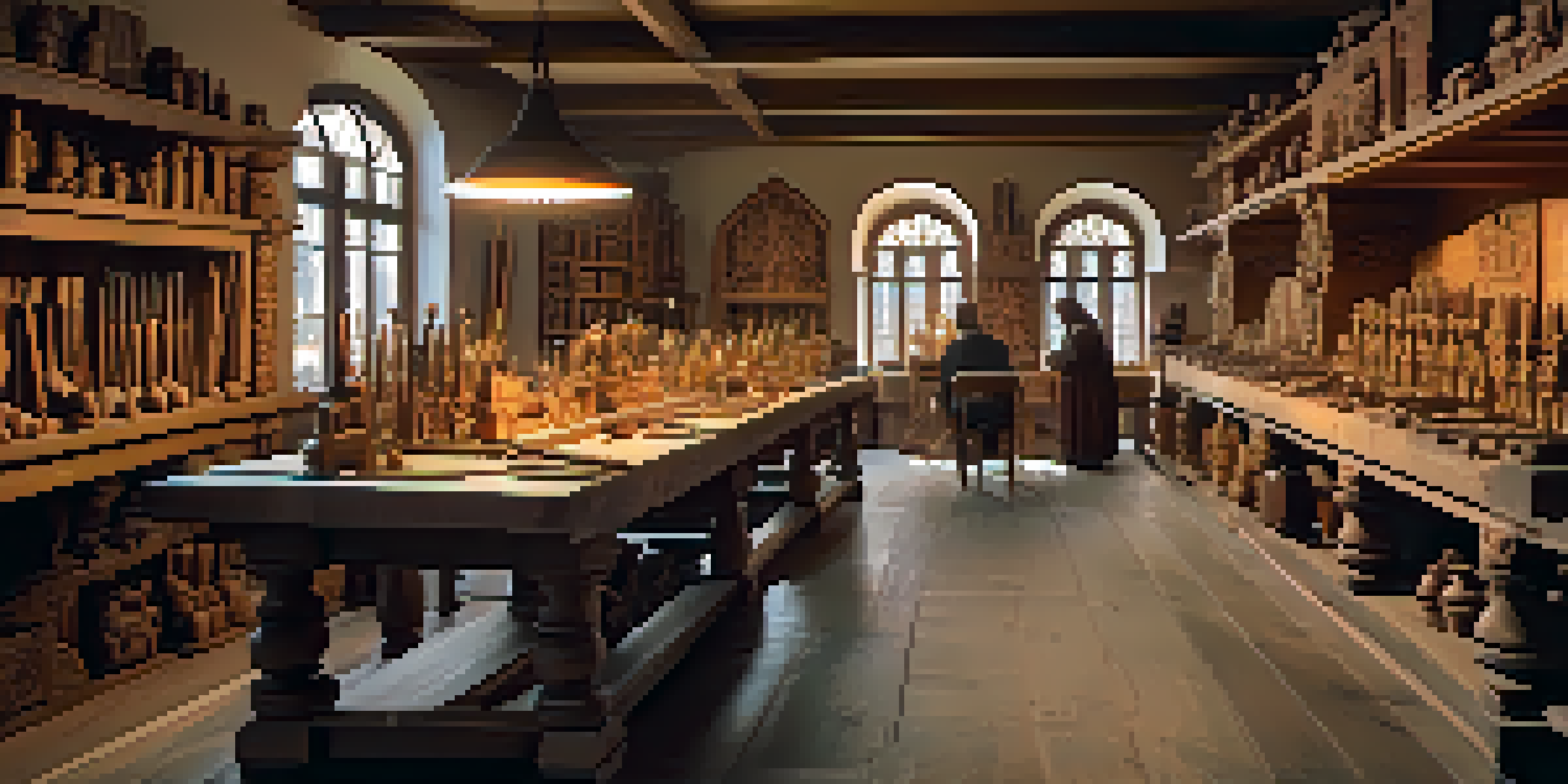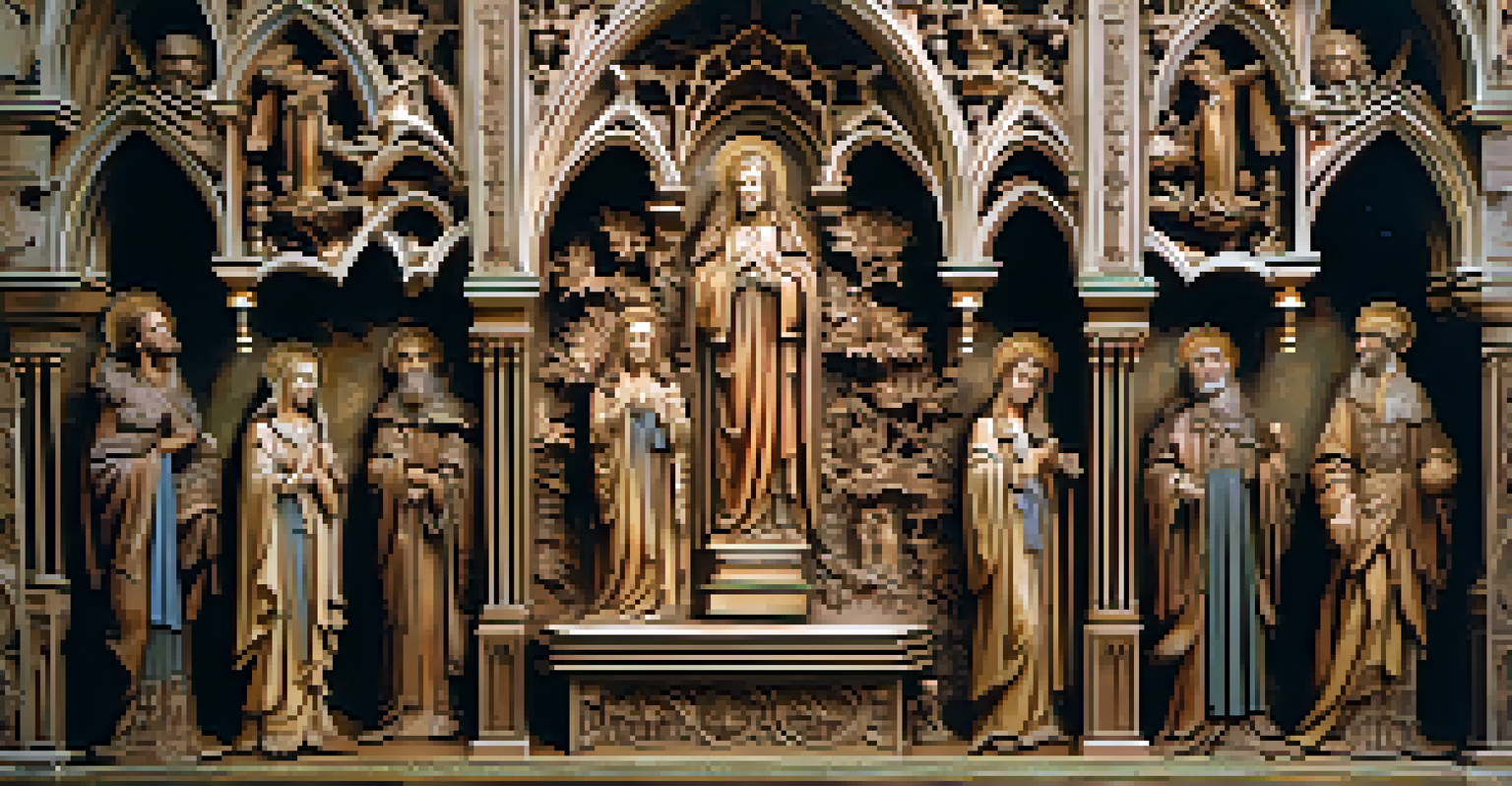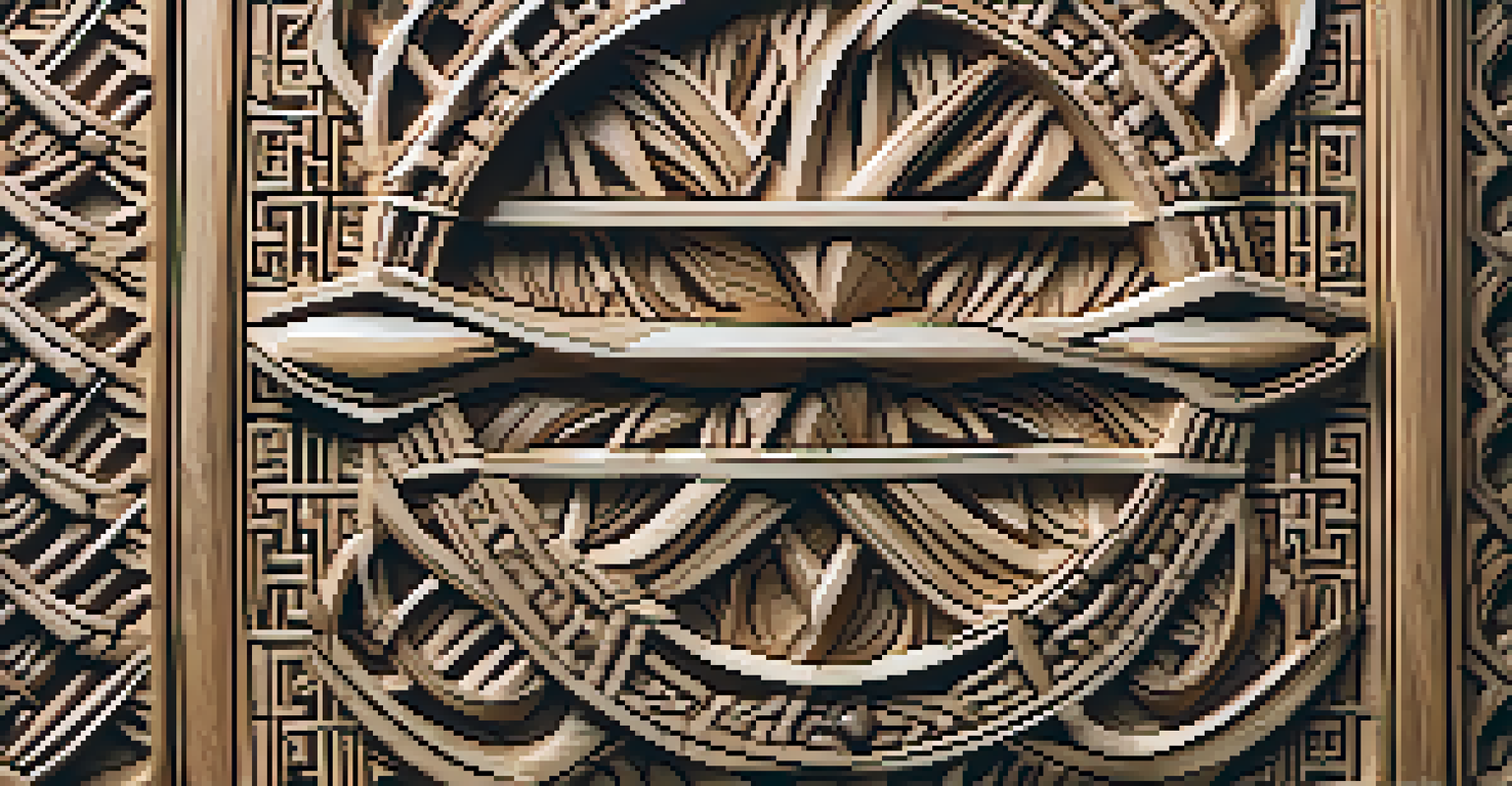Medieval Woodcarving: Styles and Techniques Explored

Understanding the Roots of Medieval Woodcarving
Medieval woodcarving has its origins in the early Middle Ages, where artisans used local materials to create functional and decorative items. This craft flourished due to the increasing demand for religious art, furniture, and architectural elements during this period. The intertwining of spirituality and artistry led to a unique form of expression that reflected the values and beliefs of the time.
Art is the most beautiful of all lies.
As guilds began to form, woodcarvers honed their skills, leading to the development of specific styles that would characterize different regions. These early woodworkers were not just craftsmen; they were storytellers, using their chisels to carve out narratives and convey messages through intricate designs. The art of woodcarving became a means to preserve history and culture in a way that was accessible to the masses.
The techniques employed during medieval times varied significantly, influenced by local traditions and available materials. From the use of softwoods like pine to harder woods like oak, each type offered unique challenges and opportunities for creativity. This adaptability allowed woodcarvers to innovate and push the boundaries of their craft, setting the stage for the remarkable works that would follow.
Key Styles of Medieval Woodcarving
Medieval woodcarving can be broadly categorized into several distinct styles, each with its own characteristics and cultural significance. Romanesque woodcarving, for instance, is known for its bold, exaggerated forms and intricate patterns, often featuring biblical themes. This style laid the groundwork for the later Gothic period, which embraced more naturalistic representations and detailed imagery.

The Gothic style, emerging in the 12th century, introduced elongated figures and elaborate motifs that showcased the artisans' skill and attention to detail. Woodcarvers began to incorporate elements like tracery and ornate foliage, which added depth and realism to their work. These advancements not only enhanced the aesthetic appeal but also reflected the shifting cultural values of the era.
Roots of Medieval Woodcarving
Medieval woodcarving emerged from local artisans creating functional and decorative items, heavily influenced by religious themes.
Other regional styles, such as the Anglo-Saxon and Celtic carvings, brought unique influences to the craft. These styles often featured knotwork and interlacing patterns that told stories and conveyed cultural significance. By examining these various approaches, we gain insight into the diverse artistic expressions that flourished across medieval Europe.
Techniques Used in Medieval Woodcarving
The techniques employed by medieval woodcarvers were as varied as the styles they created. One of the most fundamental methods was relief carving, where designs are carved into the surface of the wood, creating a raised effect. This technique allowed artisans to depict intricate scenes and figures while also ensuring that the wood remained functional for its intended use.
The artist is not a special kind of person; rather, each person is a special kind of artist.
Another important technique was in-the-round carving, which involved creating fully three-dimensional figures. This approach required a keen understanding of form and proportion, as the final piece would be viewed from multiple angles. Mastering this technique showcased a woodcarver's skill and creativity, enabling them to breathe life into their creations.
Lastly, the use of decorative techniques such as chip carving and inlay added another layer of complexity to medieval woodcarving. Chip carving involved removing small chips of wood to create geometric patterns, while inlaying involved embedding materials like ivory or metal into the wood. These techniques not only enhanced the visual appeal of the pieces but also demonstrated the craftsmanship's intricacy and depth.
The Role of Symbolism in Woodcarving
Symbolism played a crucial role in medieval woodcarving, as artisans often infused their work with deeper meanings and messages. Religious imagery was predominant, with carvings depicting saints, angels, and biblical scenes intended to inspire faith and reverence among viewers. These symbolic representations served to educate the largely illiterate population of the time, making spirituality accessible through art.
Beyond religious themes, woodcarvers also incorporated symbols from nature, mythology, and local folklore. For instance, animals like lions and eagles often represented strength and courage, while intricate floral patterns signified beauty and the transient nature of life. By weaving these symbols into their work, artisans created pieces that resonated with the cultural and spiritual beliefs of their communities.
Diverse Regional Styles
Distinct regional styles of medieval woodcarving, such as German expressive figures and Celtic knotwork, showcase the cultural influences of their origins.
As a result, each carved piece was not merely an object but a narrative that connected the viewer to the larger tapestry of medieval life. This deep-rooted symbolism has allowed modern audiences to appreciate and interpret these works in new and meaningful ways, bridging the gap between the past and present.
Influence of Religion on Woodcarving Techniques
Religion had a profound influence on the techniques and themes of medieval woodcarving. Many woodcarvers were commissioned by churches and monasteries to create altarpieces, lecterns, and other liturgical objects, which necessitated a focus on spiritual themes. This relationship between the church and artisans ensured that woodcarving remained a vital aspect of religious expression during the medieval period.
In addition to the themes, the techniques were often dictated by the intended use of the pieces. For example, altarpieces required a higher level of craftsmanship and detail, while everyday items like furniture were often simpler in design. This distinction allowed woodcarvers to adapt their skills to meet the specific needs of their patrons, showcasing their versatility and creativity.
The result was a rich tapestry of woodcarvings that not only served a functional purpose but also elevated the spiritual experience for those who encountered them. By examining these religious influences, we can better appreciate the craftsmanship that went into each piece and the significant role it played in the daily lives of medieval people.
Regional Variations in Woodcarving Styles
As medieval woodcarving spread throughout Europe, distinct regional variations began to emerge, each with its own unique flair. In Germany, for instance, woodcarvers were known for their expressive figures and elaborate altarpieces, often depicting scenes from the Bible with dramatic flair. This style reflected the local culture's emphasis on storytelling through art, making the pieces both visually stunning and narratively rich.
Meanwhile, in Italy, the Renaissance influence began to seep into woodcarving, leading to a focus on realism and human emotion. Italian artisans excelled in creating lifelike figures that captured the essence of their subjects, bringing a new level of sophistication to the craft. This shift highlighted the interplay between woodcarving and the broader artistic movements of the time.
Legacy and Modern Influence
The techniques and artistry of medieval woodcarving continue to inspire contemporary artisans, bridging the past with modern craftsmanship.
In contrast, the British Isles showcased a different approach, with Celtic influences manifesting in intricate knotwork and interlace patterns. These designs were not only visually striking but also held cultural significance, often representing themes of eternity and interconnectedness. By exploring these regional styles, we gain a richer understanding of how local traditions shaped the art of woodcarving across medieval Europe.
The Legacy of Medieval Woodcarving Today
The legacy of medieval woodcarving continues to resonate in contemporary art and design, influencing a wide range of creative disciplines. Many modern artisans draw inspiration from the intricate designs and techniques of their medieval predecessors, infusing traditional craftsmanship with contemporary aesthetics. This blend of old and new creates a unique dialogue that honors the past while embracing the future.
Museums and galleries around the world showcase medieval woodcarvings, allowing new generations to appreciate the artistic heritage of this craft. These exhibitions often highlight the skill and dedication of the artisans who created these remarkable pieces, fostering a deeper understanding of the cultural contexts in which they were made. Through this exposure, the stories and significance of medieval woodcarving remain alive and relevant.

Moreover, the revival of interest in handmade crafts has led to a resurgence in traditional woodworking techniques. Workshops and classes are now available for those eager to learn the art of woodcarving, ensuring that the skills and knowledge of this ancient craft are passed down through generations. By engaging with these practices, we not only preserve the legacy of medieval woodcarving but also celebrate its enduring impact on the world of art and craftsmanship.